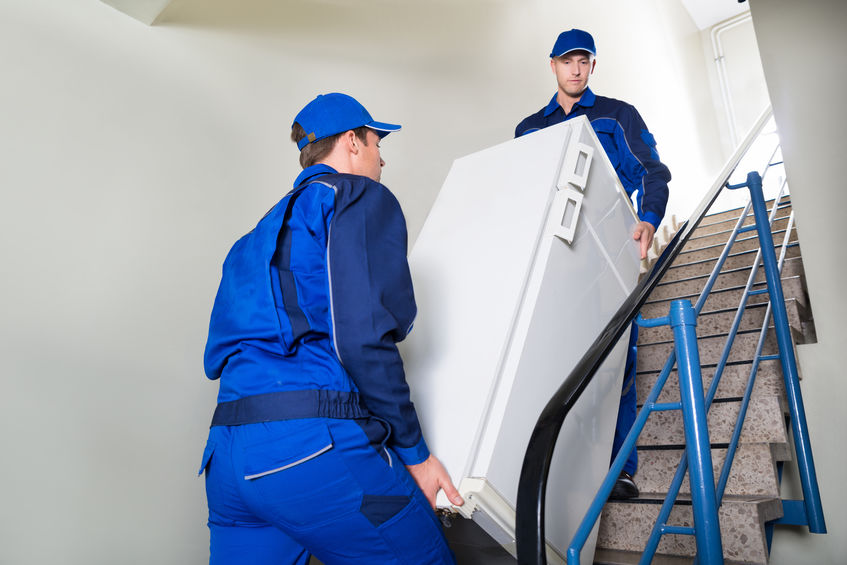The refrigerator is a household appliance now found in every home, without exception. To the point where you can't wait to buy a new one when it breaks down. This means that when you move house, the fridge is one of the first appliances to be put back into service. But how do you go about moving a fridge, whether it's a table-top, a freezer or an American fridge? What precautions should you take to ensure that it's working properly when you move in? Here's our advice on how to prepare your fridge for the move and transport it in the best possible conditions.
Before moving a fridge: what you need to do
Measure device dimensions

Before you even consider moving, you need to measure your fridge to make sure it will fit in your new home. With the advent of freezer compartments and American fridges, these appliances have grown in size and height. When moving house, it's not always possible to fit your fridge into a new kitchen, especially if it's been fitted out.
So it's a good idea to make sure that your refrigerator will fit at your new address before loading it. There's no point in going to the trouble of transporting it if you're not going to be able to use it on arrival. Rather than going to the trouble of moving it, it's often wiser to get rid of it beforehand, or to make arrangements with the new occupants. With an American fridge, it's a good idea to check whether there's a water supply in your new home to feed the ice and fresh water dispenser.
Empty the fridge
Of course, you'll need to remove all food from the fridge before loading and transporting it. To do this, you need to anticipate the moving date, especially if the fridge doubles as a freezer or has a large capacity, like an American fridge. The freezer compartment should be emptied first, and defrosted in advance if possible, so that you don't get stuck on the big day.
Make sure you have as little fresh food as possible to transport on moving day. Breaking the cold chain when transporting food can put you at completely unnecessary risk. So always carry a cooler or insulated bags to transport food on moving day, just in case...
Unplug and defrost the fridge
Depending on the model, its size and the thickness of ice accumulated since the last cleaning, defrosting a refrigerator can take more or less time. Always allow at least 2 hours. For peace of mind, we recommend you unplug your fridge the night before and leave it to defrost overnight.
Be sure to use mops to soak up any defrosting water that may spill onto the floor. It's even better to plan an early defrost a week before the move, to remove most of the frost. Once the fridge is completely empty and defrosted, you need to clean it with a sponge and disinfectant.
If you have an American fridge connected to the water network for the fresh water and ice dispenser, disconnect the hose and drain it before transporting the appliance.
Moving day: precautions for loading and transportation
Remove or fix all moving parts: shelves, compartments, doors...
As the central shelves of a fridge are mostly made of glass, it's advisable to remove them to avoid breaking them during handling and transport. You should then protect them with bubble wrap and wedges to prevent them from bumping until they arrive in your new home. If you decide to leave the plastic compartments and metal grilles inside, remember to secure them with a non-marking adhesive.
Similarly, doors should be secured with straps or tape to prevent them opening during transit. The walls and corners of the refrigerator also need to be protected for handling and transport. Ideally, you should reuse the original cardboard and protections, but you can also use cardboard (or polystyrene) covers and corners.
Provide the necessary loading equipment
You need at least two people to carry a fridge, especially if you have stairs to climb or descend. With an American fridge, there won't be too many of you. To make things easier, you can use a 3-wheel hand truck to go up and down the stairs. In any case, you need to keep the fridge upright, including during transport.
All appliance specialists will tell you: a refrigerator should never be transported horizontally. Depending on the size of your fridge, you'll need a truck that's high enough for upright storage. For the sake of convenience, it's a good idea to have a tailgate for loading. You'll then need to secure it to prevent it from moving and tipping over during transport.
After the move: time to rest before reconnecting the fridge

However, during a move, this fluid is stirred up in all directions. You need to wait until the fluid has stabilized before reconnecting the appliance. Refer to the manual for the manufacturer's instructions. If you no longer have it, allow at least 3 hours for a refrigerator, and twice that for a freezer compartment or American fridge.
Your fridge will return to its ideal temperature after about 3 days. During this time, avoid overloading your fridge and putting in food requiring low storage temperatures, such as meat or fish.
Now you have all the information you need to move your fridge with peace of mind. If you don't feel up to carrying the fridge up the stairs, you can hire professionals like Gentlemen du Déménagement to do it for you. This is particularly useful if you have a large, heavy American fridge to transport. Don't hesitate to contact us for a quote. We can also rent you a suitable truck if you want to move more cheaply, but don't have the vehicle to transport the fridge upright.
